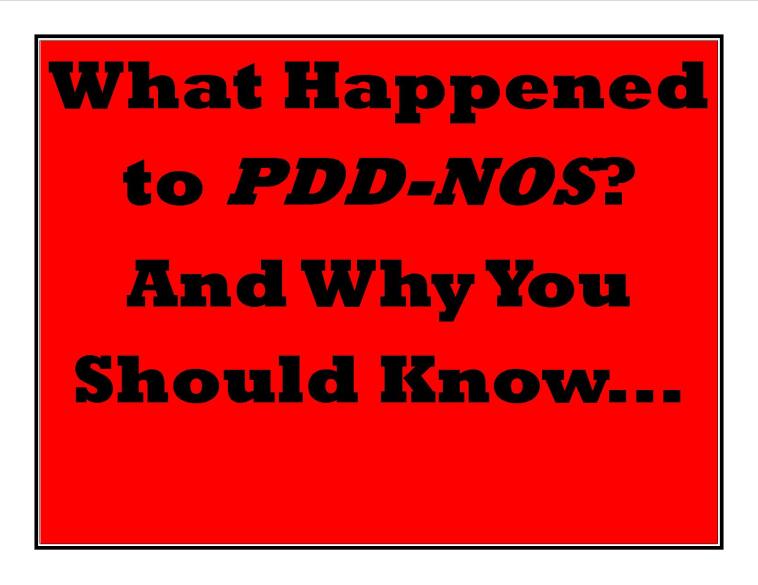The DSM-5 brought changes that – take note – not everyone on your child’s IEP team may be aware of. If there’s a psychologist present at a meeting, there shouldn’t be any confusion. But there isn’t a licensed psychologist at every IEP meeting and since only a licensed psychologist (vs. school psychologist) can make a medical diagnosis of an Autism Spectrum Disorder, other service providers might not know about the changes in the DSM-5. I’ll put all pride aside and tell you that I’m just recently, after 20 years of working with kids with special needs, learning the difference between the current educational and medical diagnosis of Autism and who makes which (that’s my goal for a future post). Embarrassing, yes. But I’m modelling old dogs learning new tricks.
But first things first – PDD-NOS – then and now…(I’ll assume that if you have any interest in this post, you already know that PDD-NOS stands for pervasive developmental disorder not otherwise specified).
The APA (American Psychiatric Association) has an information page that will be helpful in understanding the change in the diagnosis of Autism. If your child was previously diagnosed with PDD-NOS, you might want to print a copy of the APA information sheet. Go to http://www.dsm5.org and click on Autism Spectrum Disorder under ‘What’s New.’ It’s pretty simple to understand and might be a good thing to have in your child’s ‘Big Book of Everything’ – you know, the reports, evaluations, IEPs, etc. Here are a few tidbits of information from the page:
Using DSM-IV, patients could be diagnosed with four separate disorders: autistic disorder, Asperger’s disorder, childhood disintegrative disorder, or the catch-all diagnosis of pervasive developmental disorder not otherwise specified. Researchers found that these separate diagnoses were not consistently applied across different clinics and treatment centers. Anyone diagnosed with one of the four pervasive developmental disorders (PDD) from DSM-IV should still meet the criteria for ASD in DSM-5 or another, more accurate DSM-5 diagnosis. While DSM does not outline recommended treatment and services for mental disorders, determining an accurate diagnosis is a first step for a clinician in defining a treatment plan for a patient..
AND THIS –
More recently, the largest and most up-to-date study, published by Huerta, et al, in the October 2012 issue of American Journal of Psychiatry, provided the most comprehensive assessment of the DSM-5 criteria for ASD based on symptom extraction from previously collected data. The study found that DSM-5 criteria identified 91 percent of children with clinical DSM-IV PDD diagnoses, suggesting that most children with DSM-IV PDD diagnoses will retain their diagnosis of ASD using the new criteria.
But what does it all mean and why should you care?
If your child has a previous diagnosis of PDD-NOS, there is a 91% chance that he/she will retain their diagnosis of an Autism Spectrum Disorder. Now maybe you don’t want that. I’m not writing this to change anyone’s mind. However, if you believe that an educational classification of Autism is most appropriate for your child, you may need to advocate for that. The school district may look at that PDD-NOS diagnosis and tell you that it is NOT a diagnosis of Autism. Personally, that would make me nervous. If the service providers don’t know that PDD-NOS is an autism spectrum disorder, how will they provide appropriate and excellent services?
PART II
How common is it for CSE’s to decide that a child with a medical diagnosis of Autism should be classified as Speech/Language Impaired? Sometimes everyone at an IEP meeting will agree that this is appropriate. Sometimes, however, there might be disagreement. An advocacy group responded with this….
|
The final question here is – why would a CSE want to push for a Speech/Language Impaired classification? You tell me. But if your transitioning preschooler has a diagnosis of PDD-NOS, make sure your IEP committee knows that it’s an Autism Spectrum Disorder – then and now.
Has anyone else had this or a related experience? I’d LOVE to hear more about it – please share!

